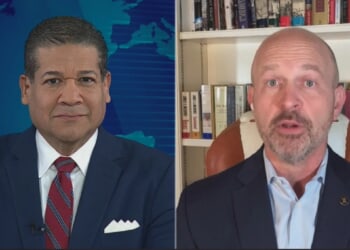SACRAMENTO, Calif. — The law-and-order tilt of Trump 2.0, especially with regard to illegal immigration, has certainly divided the country. But forgotten among the maelstrom: The first Trump term ushered in one of the more significant criminal justice reforms in decades by passing the First Step Act. If the new administration gets past its shock-and-awe stage of governance, it could actually build on these reforms in a way that at least partly bridges the nation’s vast political divide.
As the libertarian Reason Foundation explained last month, that act “included a host of reforms, most notably reducing mandatory minimums for certain drug offenses and retroactively applying the Fair Sentencing Act of 2010 to past sentencing discrepancies between crack cocaine and powdered cocaine convictions. Additionally, the First Step Act expanded the number of individuals who could receive lower than mandatory minimum sentences, and it ended sentence enhancements for gun possession in concurrent offenses.”
Various studies have shown that the act was a notable success. The left-of-center Brennan Center for Justice reported: “With over 44,000 people released under the First Step Act, the recidivism rate for this group stands at 9.7 percent, compared to 46.2 percent for all people released from Bureau of Prisons facilities in 2018.” The liberal Brookings Institution even has (relatively) high hopes for Trump 2.0, as it noted that Trump’s own tussles with the criminal justice system make him uniquely qualified to further advance related clean-slate initiatives.
“Clean slate” refers to programs that automatically clear the records of people who have completed their prison sentences and commit no additional crimes. It mostly just applies to those who committed nonviolent, low-level offenses. The problem is that people with criminal backgrounds face numerous hurdles in moving on with their lives given that they must constantly disclose their backgrounds to access jobs, housing, and public benefits. Such rules limit their opportunities and thereby increase their likelihood to reoffend.
Conservative and liberal states have in recent years been embracing the clean-slate approach, with such laws passing in dozens of states. The Trump administration has an unprecedented opportunity to expand these programs at the federal level by, as Reason’s Gary Charles explained, “pursuing expungement reforms to ease individuals’ reintegration into society.”
It’s a strange situation where Trump’s own legal problems might actually advance the case for reentry reforms. As the Prison Policy Project noted, rather starkly: “Donald Trump can still be president, but he could be barred from being a bartender, car salesman — or real estate developer.” If the voting public was willing to give the president a second chance, surely it makes sense to give thousands of ex-offenders a chance to lead relatively normal lives.
The U.S. Department of Justice has found that 95 percent of current prison inmates will at some point or another be released. Our prison system has done a horrific job on the rehabilitation end of the equation. Efforts to reduce recidivism have come to the fore given their horrific rates — nearly 82 percent nationwide within 10 years of release. Many of us who have no problem with prison serving as punishment nevertheless understand that the general public is much safer if people are less likely to commit crimes after their release.
This really is a good area for bipartisan reform, provided there’s any appetite for it these days. On April 7, I wrote my newspaper column about California’s plan to turn San Quentin Prison — the notorious Marin County prison that dates to the 1850s — “into a Scandinavian-style rehabilitation center complete with a farmer’s market, a podcast production studio and a self-service grocery store,” as the San Francisco Chronicle reported.
Based on the early reports, the plan received its share of “coddling criminal” brickbats from conservatives on social media, but based on the mostly positive responses from my conservative readership, it’s clear this isn’t that controversial of an idea given that DOJ statistic noted above. After all, the concept even received support from the prison guards’ union, which has a vested interest in improving the safety of prisons for its members.
As I asked, “If someone from San Quentin moved into your neighborhood, would you want that person to have spent the past 10 years fighting for his life as part of a skinhead gang or someone who had spent the time attending classes, gardening and playing ping pong?” Likewise, with regard to clean-slate programs: Would you want the formerly incarcerated able to get gainful employment and housing — or be stuck without a means to support themselves and tempted back into a life of crime?
As my R Street Institute colleagues Sarah Anderson and Jillian Snyder recently wrote, “In Michigan, for example, a comprehensive study found that individuals whose records were expunged had a recidivism rate of just 4 percent within five years (most for nonviolent misdemeanors). These outcomes translate into fewer police interactions and stronger community safety overall.” This is good for everyone and isn’t just touchy-feely progressive nonsense.
That Trump passed First Step in his first term is really striking – and perhaps shows that a Second Step isn’t out of the question even amid all the divisive furor.
READ MORE by Steven Greenhut:


![NYC Tourist Helicopter Falls into Hudson River, Siemens Executive and Family Among Those Killed [WATCH]](https://www.right2024.com/wp-content/uploads/2025/04/NYC-Tourist-Helicopter-Falls-into-Hudson-River-Siemens-Executive-and-350x250.jpg)






![Red Sox Fan Makes the ‘Catch of the Day’ with Unconventional ‘Glove’ [WATCH]](https://www.right2024.com/wp-content/uploads/2025/04/Red-Sox-Fan-Makes-the-‘Catch-of-the-Day-with-350x250.jpg)
![Green Day’s Cringe Trump Diss Ends in Fire and Evacuation [WATCH]](https://www.right2024.com/wp-content/uploads/2025/04/Green-Days-Cringe-Trump-Diss-Ends-in-Fire-and-Evacuation-350x250.jpg)






